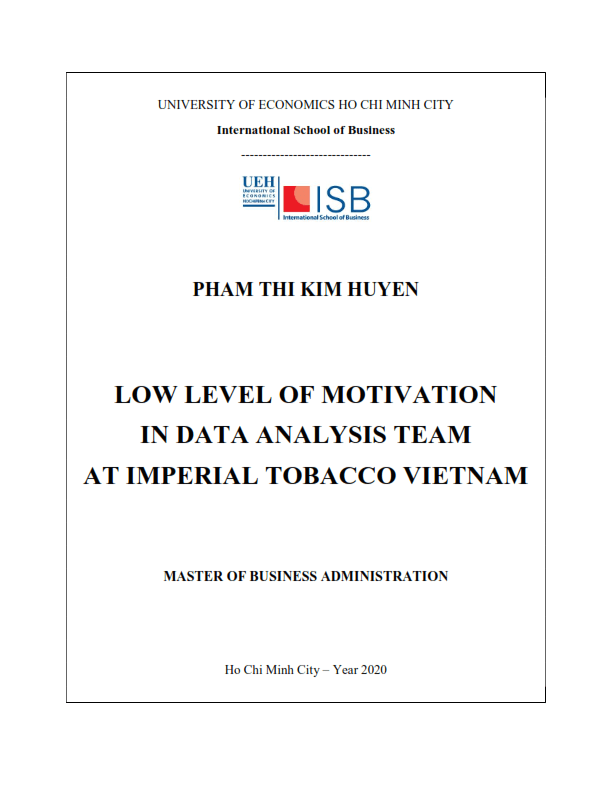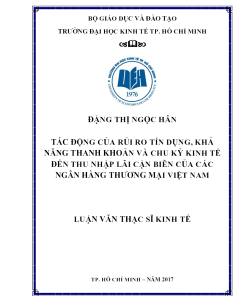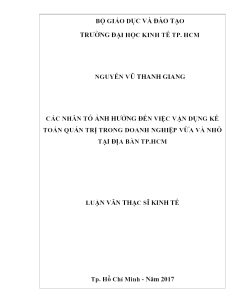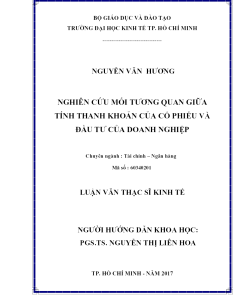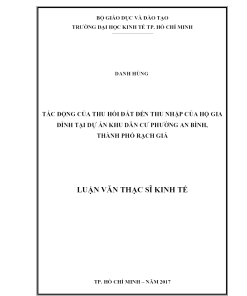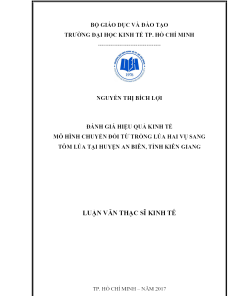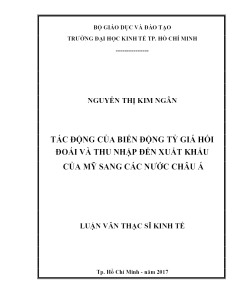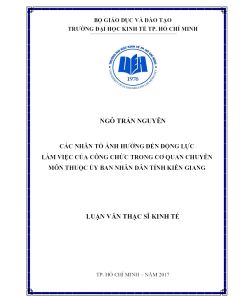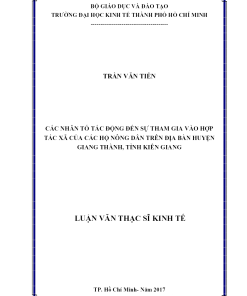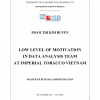Download Master Thesis: Low level of motivation in data analysis team at Imperial Tobacco Vietnam (ThS08.104)
Employees is often considered as the most valuable assets in all organizations. Recruiting and retaining employees in organizations is not only tasks of Human Resources but also involves all other departments. Therefore, managers and leaders in organizations should care about employees, understand their expectations as well as their difficulties, then give ideas to help organizations in establishing appropriate policies to attract and develop employees to retain them. By doing so, organizations can enhance employees motivation and reduce employees turnover rate, which helps to increase employees productivity and company performance.
The purpose of this research is to find out the main problem and the root cause leads to the high turnover rate in Data Analysis team at Imperial Tobacco Viet Nam Representative Office recently. With the secondary data provided by Human Resources Department and primary data collected during the in-depth interviews with three groups of the company’s leaders and the employees who are currently working in Data Analysis team and who are also left the company, it revealed that income dissatisfaction, poor working environment, and low level of motivation are potential problems lead to the high turnover rate in Data Analysis team at Imperial Tobacco Viet Nam Representative Office. Further investigating the underlying problems by analyzing the interview results and using the theories from literature, the main problem is identified as the low level of motivation, especially extrinsic motivation, which caused by benefits inequity and job insecurity, that leads to the high turnover rate in Data Analysis team at Imperial Tobacco Viet Nam Representative Office. After finding the root cause of high turnover rate, alternative solutions are designed and justified.
The solution to eliminate benefits inequity as well as reduce job insecurity by revising the company benefit policies and enhancing engagement meetings for sharing company strategies to the employees is suggested by the managers, selected by the indirect employees and supported by the company Director for execution. Then, the detailed action plan of this solution is presented to the company for implementation to solve the problem.
Keywords: Personnel management, Employee motivation
ThS08.104_Low level of motivation in data analysis team at Imperial Tobacco Vietnam
TABLE OF CONTENT
LIST OF FIGURE........................................................................................................................... 1
LIST OF TABLE ............................................................................................................................ 1
Executive Summary ........................................................................................................................ 2
Acknowledgements......................................................................................................................... 3
1. COMPANY INTRODUCTION .............................................................................................. 4
1.1 Company overview ............................................................................................................. 4
1.2 Organizational structure ...................................................................................................... 5
2. PROBLEM CONTEXT........................................................................................................... 7
2.1 Symptoms............................................................................................................................ 7
2.2 Symptom validation and justification ............................................................................... 11
3. PROBLEM IDENTIFICATION .......................................................................................... 14
3.1 Problem mess .................................................................................................................... 14
3.2 Potential Problems and validate the main problem........................................................... 16
3.2.1 .Income dissatisfaction -----------------------------------------------------------------------16
3.2.2 .Poor working environment------------------------------------------------------------------18
3.2.3 .Low level of motivation----------------------------------------------------------------------21
3.3 Updated preliminary cause and effect map....................................................................... 24
3.4 Problem justification ......................................................................................................... 25
4. CAUSE VALIDATION ......................................................................................................... 27
4.1 Potential causes ................................................................................................................. 27
4.1.1 .Lack of Intrinsic motivation: ---------------------------------------------------------------28
4.1.2 .Low level of Extrinsic motivation: ---------------------------------------------------------29
4.2 Cause justification............................................................................................................. 31
5. ALTERNATIVE SOLUTIONS ............................................................................................ 33
5.1 Alternative solution 1: Eliminate benefits inequality........................................................ 33
5.2 Alternative solution 2: Ensure the employees’ job security ............................................. 36
5.3 Solution justification ......................................................................................................... 38
6. ORGANIZATION OF ACTIONS........................................................................................ 41
6.1 Contents of organization of action .................................................................................... 41
6.2 Timeline of implementation.............................................................................................. 42
7 CONCLUSION....................................................................................................................... 44
8 SUPPORTING INFORMATION......................................................................................... 45
8.1 Interview Guide................................................................................................................. 47
8.2 Questionnaire .................................................................................................................... 50
8.3 Summary of transcripts ..................................................................................................... 51
REFERENCES............................................................................................................................ 69
LIST OF FIGURE
Figure 1. ITVN Operation diagram ................................................................................................ 5
Figure 2. ITVN Organization Chart................................................................................................ 6
Figure 3. Turnover trend - Talentnet – Mercer post survey report 2018 ........................................ 8
Figure 4. Top 3 & Bottom 3 Turnover - Talentnet – Mercer post survey report 2018................. 10
Figure 5. Turnover rate at ITVN................................................................................................... 12
Figure 6. Preliminary cause and effect tree .................................................................................. 15
Figure 7. Updated preliminary cause and effect map ................................................................... 24
Figure 8. Cause and effect map..................................................................................................... 31
LIST OF TABLE
Table 1. Total employee turnover rate at ITVN ............................................................................. 7
Table 2. Breakdown employee turnover rate at ITVN in 2018 and 2019....................................... 9
Table 3. Turnover rate of Data Analysis Team............................................................................. 11
Table 4. Replacement costs of Data Analysis Team..................................................................... 13
Table 5. Costs to implement solution 1 ........................................................................................ 35
Table 6. Costs to implement solution 2 ........................................................................................ 38
Table 7. Questionnaire .................................................................................................................. 40
Table 8. Survey results.................................................................................................................. 40
Table 9. Detailed action plan ........................................................................................................ 41
Table 10. Implementation plan ..................................................................................................... 43
1
Executive Summary
Employees is often considered as the most valuable assets in all organizations. Recruiting and retaining employees in organizations is not only tasks of Human Resources but also involves all other departments. Therefore, managers and leaders in organizations should care about employees, understand their expectations as well as their difficulties, then give ideas to help organizations in establishing appropriate policies to attract and develop employees to retain them. By doing so, organizations can enhance employees motivation and reduce employees turnover rate, which helps to increase employees productivity and company performance.
The purpose of this research is to find out the main problem and the root cause leads to the high turnover rate in Data Analysis team at Imperial Tobacco Viet Nam Representative Office recently. With the secondary data provided by Human Resources Department and primary data collected during the in-depth interviews with three groups of the company’s leaders and the employees who are currently working in Data Analysis team and who are also left the company, it revealed that income dissatisfaction, poor working environment, and low level of motivation are potential problems lead to the high turnover rate in Data Analysis team at Imperial Tobacco Viet Nam Representative Office.
Further investigating the underlying problems by analyzing the interview results and using the theories from literature, the main problem is identified as the low level of motivation, especially extrinsic motivation, which caused by benefits inequity and job insecurity, that leads to the high turnover rate in Data Analysis team at Imperial Tobacco Viet Nam Representative Office.
After finding the root cause of high turnover rate, alternative solutions are designed and justified. The solution to eliminate benefits inequity as well as reduce job insecurity by revising the company benefit policies and enhancing engagement meetings for sharing company strategies to the employees is suggested by the managers, selected by the indirect employees and supported by the company Director for execution. Then, the detailed action plan of this solution is presented to the
company for implementation to solve the problem.
2
Acknowledgements
I would like to express my appreciation to all people who supported me during my studies. First, I would like to send my thankfulness and special appreciation to my supervisor, Dr. Nguyen Thi Mai Trang, who has kindly supported, guided, advised, and motivated me to complete this thesis. Then, I would like to thank my managers, my colleagues at Imperial Tobacco Vietnam Representative Office who gave me chances for conducting interviews and spent their valuable times for giving me comments and opinions which helps me to come up the results of this thesis. In addition, I would like to send my regards to all of my classmates of MBA 9 for their support,
encouragement and giving me strength in all the time writing this thesis.
3
1. COMPANY INTRODUCTION
1.1 Company overview
Imperial Tobacco is a group of subsidiaries of Imperial Brands (1), one of the biggest corporations in tobacco industry in the world. Imperial Tobacco subsidiaries manufacture and trade a range of cigarettes, tobacco products, cigars, and tobacco accessories such as papers and tubes. Imperial Tobacco International Limited Company in United Kingdom has established its representative office in Ho Chi Minh city, Viet Nam since 1995 and the office is called Imperial Tobacco Vietnam Representative Office (ITVN). ITVN’s scope of activities is a liaison office, conducting market surveys, identifying and accelerating the trade opportunities in Vietnam market on behalf of the Head Office in United Kingdom. ITVN is not allowed to conduct any directly profitable activities in Vietnam, but only supports the Head Office (Imperial Tobacco International Limited Company in United Kingdom) to boost sales of the company’s products in Vietnam market. Therefore, ITVN is responsible for spending investments to increase the quantity of the company’s products selling in Vietnam market, because the more company’s products are sold in Vietnam market, the more profits the Head Office are earned.
The key product of ITVN is Bastos cigarettes, which are producing by local manufacturer under the licensing contract with Imperial Tobacco International Limited Company in United Kingdom. Bastos cigarettes have been produced and sold in Vietnam market for nearly 25 years, and up to now, Bastos cigarette brand is in the list of top ten selling brands in Vietnam, gaining its market share around 5% (based on data of AC Nielsen 2018). Bastos cigarette brand is strength in mainstream segment, having price ranges from 10.000 dong to 12.000 dong per pack of 20 cigarette sticks. The key competitors of Bastos cigarettes in the same price segment is Thang Long cigarettes and Sai Gon cigarettes, which are produced by Vinataba, a state-own corporation.
The operation diagram of Imperial Tobacco in Vietnam market can be described in the Figure 1 as below:
4
Imperial Tobacco International Limited Company in United Kingdom (Head Office)
Supply materials based on licensing contract
Earnings profits on material supplied and Royalty fees on products sold
Dong Nai Food Industrial Corporation (Manufacturer)
Funding for ITVN activities
Distribution channel of Bastos products in Vietnam market
Imperial Tobacco Vietnam Representative Office (ITVN)
Investment to distribution channel to boost sales
Distributors in
Vietnam
Figure 1. ITVN Operation diagram
(Source: ITVN Management Department)
Besides, Imperial Tobacco Vietnam Representative Office inherits six values from Imperial Brands: we can, I own, I am, we surprise, I engage, we enjoy. Those values are focused to employees’ competency, performance, motivation, and retention. Furthermore, Imperial Brands has built the Leadership Expectations that give opportunities for not only leaders but also employees to drive performance, to take accountability, to build capability, to lead by example, to improve and learn, and to create great teams.
1.2 Organizational structure
At the end of the year 2019, ITVN has 20 direct employees who are working in 6 departments in ITVN, which are: Operation Support, Human Resource (HR& Admin), Finance, Marketing, Sales, and Business Intelligence. Besides, ITVN also has 12 indirect employees working in Data Analysis Team who are reported to Business Intelligence Manager of ITVN. Those indirect employees working in Data Analysis Team are having their labor contracts signed with the labor supply
agency of ITVN, Humidor Company. Though having salary paid by ITVN through Humidor
5
Company, the recruitment process of Data Analysis Team is done by Human Resource Department of ITVN. This means ITVN is responsible for recruitment, training, appraising, and paying salary to the direct and indirect employees. However, although working in the same office, there is a difference in benefits between the direct employees and the indirect employees of ITVN, in which the direct employees - who have labor contracts signed with the Representative Office - have some additional benefits such as yearly performance bonus, healthcare insurance for their family, while the indirect employees – who have labor contracts signed with the labor agency – do not have those types of benefits. Furthermore, the direct employees of ITVN are official headcounts of Imperial Brands, so they have employee codes which can be used to log in the intranet websites and access to online resources of Imperial Brands. The organization structure of ITVN is described
in Figure 2 below.
Labor contract signed with ITVN
Data
Analysis
Team
Labor contract signed with Agency
Figure 2. ITVN Organization Chart
(Source: ITVN Human Resource Department)
Data Analysis team has been established since 2015, and the purpose of having this team is to collate and analyze market data of tobacco industry and ITVN’s competitors in Vietnam market. The daily tasks of Data Analysis team are to input daily data collected from market to the internal system, keep track of Bastos cigarettes sell-in, sell-out volumes and cigarette inventories of distributors and wholesalers, to run and analyze the reports regarding the Bastos cigarettes and its competitors. Those type of reports will help the Business Intelligence Manager having a clearer
picture of the whole tobacco industry in Vietnam market so that he can support the Director for
6
decision making. The Director is responsible for all operations and activities of ITVN, as well as provides strategies to the head quarter for future growth of ITVN.
Before 2015, without Data Analysis team, ITVN had to buy the market data of tobacco industry and ITVN’s competitors in Vietnam market from AC Nielsen, which costs about 5 billion dongs per year. Therefore, from 2015, the Director of ITVN made the decision to form up a Data Analysis Team to do collating and analyzing tasks regarding the market data. The total employment costs for Data Analysis team is about 2 billion dongs per year, and the total cost for collecting raw data from market is around 1 billion dongs per annum. Having Data Analysis team, ITVN can save about 2 billion dongs per year while ITVN still has the same results of having reports regarding the market data of tobacco industry and competitors in Vietnam market.
2. PROBLEM CONTEXT
2.1 Symptoms
Though Imperial Tobacco Vietnam Representative Office and its Group has a strong and clear strategy to attract, motivate, and retain people, the voluntary turnover rate of the employee at ITVN was high in the past two years, and increased significantly in 2019. This is a symptom that needs to be validated, identify the problems, analyze and diagnose the problems to find out the root cause, then provide the solutions and implementation plans to improve the company situation.
Based on the data collected from Human Resource Department of ITVN, the voluntary turnover rate of total direct and indirect employees at ITVN is showed in Table 1 as below:
Table 1. Total employee turnover rate at ITVN
Year 2016 2017 2018 2019 Q1/2020
Total number of employee
(at the year-end)
34 35 35 32 31
Total resigned 5 6 8 10 2
Replacement 6 6 5 9 3
Turnover rate 15% 17% 23% 30% 6%
(Source: ITVN Human Resource Department)
7
Turnover rate is the percentage of the employees leaving the organization during a period of time. Turnover rate is calculated by using “the total number of employees leaving the organizations during the month divided by the average number of employees during the month”, postulated by Phillips as cited by Hernández et al (2).
Table 1 showed that the turnover rate of total employee at ITVN in 2019 at 30%, which is significantly higher than 2017 and 2018 and has an increasing trend year on year. Besides, the post survey seminar report from Talentnet-Mercer in October 2018 (3) (see Figure 3) showed that the voluntary staff turnover rate is 15.1% in 2017 and its trend is to increase to 15.6% in 2018 in multinational corporations (MNC).
Figure 3. Turnover trend - Talentnet – Mercer post survey report 2018
Comparing the employee turnover rate at ITVN during the past four years with the staff turnover rate in local companies and also multinational corporations, it can say that the total employee turnover rate at ITVN is significantly high in 2018 and 2019.
As ITVN is a representative office of Imperial Tobacco International Limited Company in United Kingdom which is a subsidiary of Imperial Brands - a global corporation - therefore, ITVN inherits all factors of a multinational corporation. Since cigarette and tobacco is a special type of business
that requires Vietnam Government’s controls, thus it is not allowed Imperial Tobacco International
8
Limited Company in United Kingdom to establish a company limited in Vietnam, but just only a representative office. Despite the business license of a representative office, ITVN is still considered a multinational corporation, same as its competitors such as British American Tobacco (BAT), Phillip Morris International (PMI), and Japanese Tobacco International (JTI). Therefore, the employee turnover rate of ITVN can be compared with the staff turnover rate in MNC.
In addition, the breakdown turnover rate data for 2018 and 2019 provided by Human Resource Department of ITVN (Table 2) showed the details of turnover rate by department at ITVN. There is a huge gap in turnover rate between the direct employee and the indirect employee at ITVN, in which the turnover rate of the direct employee is less than 10% in these two years, while the turnover rate of the indirect employee at ITVN is significant high in 2018 (50%) and 2019 (64%). Due to the high turnover rate of the indirect employee at ITVN, which is Data Analysis team, leads to the increasing in total turnover rate of the whole ITVN, 23% in 2018 and 30% in 2019.
Table 2. Breakdown employee turnover rate at ITVN in 2018 and 2019
Year 2018 Year 2019
Yearly turnover rate
in ITVN, breakdown by department
Average number of employee
Number of resigned employee
Turnover rate
Average number of employee
Number of resigned employee
Turnover rate
Direct employee 23 2 9% 21 2 10% HR & Admin 8 1 13% 6 1 17% Finance 3 0 0% 3 0 0% Marketing 4 1 25% 4 1 25% Sales 3 0 0% 3 0 0% Business Intelligence 2 0 0% 2 0 0% Operation Support 3 0 0% 3 0 0%
Indirect employee 12 6 50% 13 8 64% Data Analysis 12 6 50% 13 8 64% Total 35 8 23% 34 10 30%
(Source: ITVN Human Resource Department)
Besides, the post survey seminar report from Talentnet-Mercer in October 2018 (2) also showed that the highest turnover rate in 2018 is 37.6% belongs to Retail industry in Vietnam market (see
Figure 4).
9
Figure 4. Top 3 & Bottom 3 Turnover - Talentnet – Mercer post survey report 2018
ITVN is participating in annual surveys conducted by Talentnet-Mercer on human resources topics, such as compensation and benefits trend, voluntary staff turnover trend, which conducting within organizations in retails industry and also in tobacco industry. The post survey report 2018 of Talenet-Mercer has been conducted with 602 organizations in 16 industries. This survey report shows the trends of voluntary staff turnover rate within those organizations and industries.
Based on the data in Table 2, the turnover rate of Data Analysis Team at ITVN in 2018 is significantly higher than the staff turnover rate in MNC, 50% versus 15.6%, and about 2.5 times higher than the staff turnover rate in local company (20.2%). Furthermore, this turnover rate of Data Analysis Team in 2018 is higher than the highest turnover rate in Retails industry in 2018 of
37.6% (Figure 4). In 2019, the turnover rate of Data Analysis Team at ITVN increased to 64% (Table 2), that is a symptom needs to identify its problems and causes.
As stated in Section 1.2 Organizational structure, Data Analysis team is indirect employees of ITVN, whose employment contract has been signed with the labor supply agency of ITVN, Humidor. Despite signing labor contracts with the agency, Data Analysis Team is following the recruitment and training processes of ITVN, working in ITVN’s office, and reporting to ITVN’s Business Intelligence Manager. Thus, Data Analysis Team is reported as indirect employees of ITVN, having their recruitment and training costs, and salary paid by ITVN through agency. It can
be said that Data Analysis team is part of the ITVN workforce and cost to ITVN’s employment
10
costs. As a result, any change in direct and indirect employees leads to the increasing in the employment costs of ITVN. Therefore, it is crucial for ITVN to manage their workforce to eliminate their employment costs for better performance. Hence, the high voluntary turnover rate in Data Analysis Team is a symptom that the Management of ITVN needs to investigate its causes and design solutions to solve the issue.
2.2 Symptom validation and justification
With the detailed data provided by Human Resource Department of ITVN in Table 2, it showed that Data Analysis team has the highest turnover rate comparing to other departments at ITVN during the past four years. The turnover rate of Data Analysis Team is more than two times comparing to the total turnover rate of ITVN. It is showed in Table 3 below:
Table 3. Turnover rate of Data Analysis Team
Year 2016 2017 2018 2019 Q1/2020
Number of Data Analysis employee
(at the year-end)
10 11 13 12 11
Total quit 3 3 6 8 2
Turnover rate of Data Analysis Team
(Indirect employee)
Turnover rate of other Departments
(Direct employee)
30% 29% 50% 64% 17%
8% 13% 9% 10% 0%
Total Turnover rate of ITVN 15% 17% 23% 30% 6% (Source: ITVN Human Resource Department)
The data from Table 3 showed that the turnover rate of Data Analysis team in 2019 is significantly higher than 2018, 64% versus 50%, and it is more than two times higher than 2017 (29%), with an increasing trend since 2018. It can say that the turnover rate of Data Analysis team is the highest number among the turnover rate of all the departments at ITVN (Table 2), and also is much higher than the retails industry data (Figure 4).
Total turnover rate of ITVN is illustrated by the chart below (Figure 5)
11
70%
64.0%
60%
50%
50.0%
40%
30%
20%
30.0% 28.6%
17.4%
14.7%
22.9%
29.9%
10%
8.3%
12.5% 8.7% 9.5%
0%
2016 2017 2018 2019
Turnover rate of Indirect employee Turnover rate of Direct employee
Total turnover rate of ITVN
Figure 5. Turnover rate at ITVN
Though the interview, Ms. Tran Hanh – HR Manager of ITVN, said that:
“We have to pay to the agency for the recruitment fees, at about 2 times of monthly salary. Besides, we need to spend time for induction, training, then the newcomers can familiar with their tasks after about two month. During this time, we have to pay overtime wages for the others to complete the task requirements on time. Also, it costs our managers time for interviewing and training”.
Mr. Tran Son – Business Intelligence Manager of ITVN, shared his opinions:
“I am the person suffering most for the resignation of my team members. I have to re-assign tasks for others when someone leaving till we have a replacement one. Also, it takes my time for interview, training, coaching, assessing newcomers. It takes at least 2-3 months for the new one to get familiar with their tasks”.
According to Mr. Andrew Wang – Director of ITVN, the company performance is decreasing because the company has to spend money for recruitment and training costs. Besides, the higher
the turnover rate, the lower the productivity of the employees. He said:
12
“Of course, we have to spend for recruitment and training costs. The productivity of a whole team is also lower than normal. New employees need time to get used to their work, to get familiar with their team, and to coordinate smoothly with colleagues to have the teamwork tasks done. In addition, other people in the team need to spend their time to guide newcomers, therefore, the team’s work is slowed down”.
The data from Human Resource Department of ITVN (Table 4) showed the replacement costs spent for recruitment and training, overtime wages paid for other team members to complete the reports on time, facilities such as uniform and working tools of Data Analysis Team in the past two year 2018 and 2019.
Table 4. Replacement costs of Data Analysis Team
Replacement cost of Data Analysis team
(in million dongs)
Year 2018 Year 2019 Increasing %
of cost YoY
Recruitment cost 90 168
Training cost 25 35
Overtime wages 30 63
Other facilities 25 35
Total replacement cost of Data Analysis
team 170 301 177%
Total Employee costs of Data Analysis
team 1,872 1,950
Percentage of replacement cost in total
cost of Data Analysis team 9.1% 15.4%
(Source: ITVN Human Resource Department)
Table 4 showed the replacement cost of Data Analysis team in 2019 increases 177% versus 2018, and the percentage of replacement cost in total employee costs of this team increases from 9.1% in 2018 to 15.4% in 2019. That means ITVN has paid more for Data Analysis team's replacement costs in 2019.
According to Michael et al. (4), labor cost is significant, then the leakage of human capital by unnecessary turnover is one of important factor affecting to the performance of the company.
13
According to Lashley and Chaplain as cited by Michael et al. (4), employee turnover is not only a significant tangible money cost but also intangible or hidden cost related to loss of skills, inefficiency, and replacement costs. In addition, Abbasi et al. (5) stated that besides visible costs of turnover such as costs of termination, advertising, recruitment, selection, hiring, training, and assigning, there are many hidden costs such as disruption of customer relations, the erosion of morale and stability of those who remain, the loss of valuable time which the new comers acquire their tasks and achieve efficiency.
Through the interview results and the data provided by Humane Resource Department of ITVN, the visible replacement costs of Data Analysis team can be calculated and recorded, while other hidden costs such as low employee productivity, loss of time of managers, which cannot be calculated. Since the turnover rate of Data Analysis team at ITVN is the highest among other departments at ITVN, and it has an increasing trend, therefore, further investigations are focused to the symptom of high turnover rate of Data Analysis team at ITVN.
3. PROBLEM IDENTIFICATION
3.1 Problem mess
In order to find out the problems leading to high turnover rate in Data Analysis team at ITVN, qualitative research method were used and in-depth interviews have been conducted with three groups. The first group consists of three persons, who are at the manager levels: Ms. Tran Hanh - HR Manager, Mr. Tran Son – Business Intelligence Manager, and Mr. Andrew Wang - Director of ITVN. The second group is the employees currently working in Data Analysis team, and the third group is the employees who left Data Analysis team.
Ms. Tran Hanh – HR Manager, shared the results from her exit interviews that people left Data Analysis team because of having better jobs with higher salary and better benefits. From her point of view, reasons for employees working in Data Analysis team quitting their jobs are low salaries and unequal benefits that make them dissatisfied.
The interview with Mr. Tran Son – Business Intelligence Manager, has revealed some reasons that people leaving the company because of low salary, no career growth, and unstable jobs. According to Mr. Tran Son - Business Intelligence Manager, people in Data Analysis team quit their jobs because of job insecurity and no retention plan that makes the staff feel unengaged with the
company.
14
The opinion from the Director, Mr. Andrew Wang, that workplace condition makes Data Analysis team unconnected with other people in the company. According to Mr. Andrew Wang, may be the nature of the tasks of Data Analysis team which requires a silence working area to focus on their tasks, so this makes them low-engaged with other groups in the company.
The interviews with the staffs who are working and who left Data Analysis team released some information about their decision of quitting their jobs. There are low incomes, inequity benefits, isolation and working apart from other departments, job insecurity, no retention, no career growth opportunities and development plans.
With all the information collected from the first round interviews with the HR Manager, the Business Intelligence Manager, the Director, the existing staff and the staff who left Data Analysis team, and combined with the theory in the book Problem Solving in Organizations of Joan Van Aken and Hans Berends - Third edition 2018 (item 4.3, page 55-58) (6), the potential problems can
be described in the preliminary cause and effect tree as below:
Isolation
Low engagement
Working apart Poor Working environment
Unstable jobs
High turnover rate of employee
Increase recruitment and training costs
No career development plan
Lack of
Motivation
Low employee productivity
No career growth opportunity
Low salary &
uncompetitive benefits
Figure 6. Preliminary cause and effect tree
15
3.2 Potential Problems and validate the main problem
From the above preliminary cause and effect map, there are three potential problems that identified from the interviews are income dissatisfaction, poor working environment, and low level of motivation which caused the high turnover rate in Data Analysis team at ITVN. Further analysis from the interview results and combined with literature will help to find out the main problem that leads to high turnover rate in Data Analysis team at ITVN.
3.2.1 Income dissatisfaction
According to Mercy et al. (7), salary is defined as a fixed amount of money paid to a worker usually measured at a monthly and yearly basic, salary is compensation that an employer paid to an employee in return of work done. Besides, Matz et al. and Crow et al. as cited by Schuck et al. (8), stated that salary factor is important in understanding job satisfaction and organizational commitment as well as voluntary turnover. In addition, Carraher (9) indicated that salary and satisfaction with salary are important factors for attracting and retaining employees. Luna-Arocas et al (10) stated that salary and benefits are related to pay satisfaction. According to Luna-Arocas et al (10), money is a motivator, and there is a positive relationship between income and satisfaction. This means that low salary and uncompetitive benefits lead to income dissatisfaction of the employees, then reduce their retention to work. Therefore, if employees are unsatisfied with their salary, they may look for another job to get a better income.
The interview conducted with Ms. Tran Hanh - HR Manager, mentioned that one of the reasons why the employees at Data Analysis team left the company is income dissatisfaction. She said:
“I usually conduct exit interviews with people who want to leave the company. Some of them said that they received job offers with higher salary. Some people said that they were unhappy with their benefits here”.
An employee who is currently working in Data Analysis team – Mr. Nguyen Tung, shared his opinion about the salary:
“My salary is not very attractive. I know that the salary will be reviewed and increased every year, but the percentage of increasing is not much”.
The results from interviews with another employee – Mr. Nguyen Thien, who already left Data
Analysis team, indicated that he did not happy with his salary and benefits. He shared:
“The salary there is lower than my current job. In addition, benefits are not attractive. We don’t have annual performance bonus, except for the thirteenth month salary.”
16




